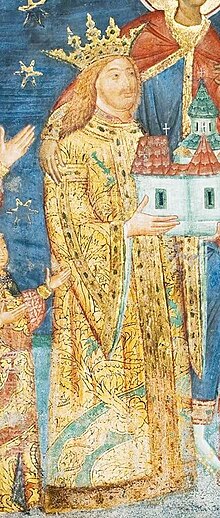| Stephen the Great Ștefan cel Mare | |
|---|---|
 Fresco of Stephen in the Voroneț Monastery (1488) | |
| Prince of Moldavia | |
| Reign | 14 April 1457– 2 July 1504 |
| Predecessor | Peter III Aaron |
| Successor | Bogdan III the One-Eyed |
| Born | 9 or 16 January 1433–1440 |
| Died | 2 July 1504 Suceava |
| Burial | |
| Spouse | Mărușca (?) Evdochia of Kiev Maria of Mangup Maria Voichița of Wallachia |
| Issue more... | Alexandru Bogdan III Petru Rareș |
| Dynasty | Mușat |
| Father | Bogdan II of Moldavia |
| Mother | Maria Oltea |
| Religion | Eastern Orthodox |
| Military career | |
| Service | Moldavian military forces |
| Battles / wars | |
Stephen III, commonly known as Stephen the Great (Romanian: Ștefan cel Mare; pronunciation: [ˈʃtefan tʃel ˈmare]); died 2 July 1504), was Voivode (or Prince) of Moldavia from 1457 to 1504. He was the son of and co-ruler with Bogdan II, who was murdered in 1451 in a conspiracy organized by his brother and Stephen's uncle Peter III Aaron, who took the throne. Stephen fled to Hungary, and later to Wallachia; with the support of Vlad III Țepeș, Voivode of Wallachia, he returned to Moldavia, forcing Aaron to seek refuge in Poland in the summer of 1457. Teoctist I, Metropolitan of Moldavia, anointed Stephen prince. He attacked Poland and prevented Casimir IV Jagiellon, King of Poland, from supporting Peter Aaron, but eventually acknowledged Casimir's suzerainty in 1459.
Stephen decided to recapture Chilia (now Kiliia in Ukraine), an important port on the Danube, which brought him into conflict with Hungary and Wallachia. He besieged the town during the Ottoman invasion of Wallachia in 1462, but was seriously wounded during the siege. Two years later, he captured the town. He promised support to the leaders of the Three Nations of Transylvania against Matthias Corvinus, King of Hungary, in 1467. Corvinus invaded Moldavia, but Stephen defeated him in the Battle of Baia. Peter Aaron attacked Moldavia with Hungarian support in December 1470, but was also defeated by Stephen and executed, along with the Moldavian boyars who still endorsed him. Stephen restored old fortresses and built new ones, which improved Moldavia's defence system as well as strengthened central administration. Ottoman expansion threatened Moldavian ports in the region of the Black Sea. In 1473, Stephen stopped paying tribute (haraç) to the Ottoman sultan and launched a series of campaigns against Wallachia in order to replace its rulers – who had accepted Ottoman suzerainty – with his protégés. However, each prince who seized the throne with Stephen's support was soon forced to pay homage to the sultan.
Stephen eventually defeated a large Ottoman army in the Battle of Vaslui in 1475. He was referred to as Athleta Christi ("Champion of Christ") by Pope Sixtus IV, even though Moldavia's hopes for military support went unfulfilled. The following year, Ottoman Sultan Mehmed II routed Stephen in the Battle of Valea Albă, but the lack of provisions and the outbreak of a plague forced him to withdraw from Moldavia. Taking advantage of a truce with Matthias Corvinus, the Ottomans captured Chilia and their Crimean Tatar allies Cetatea Albă (now Bilhorod-Dnistrovskyi in Ukraine) in 1484. Although Corvinus granted two Transylvanian estates to Stephen, the Moldavian prince paid homage to Casimir, who promised to support him to regain Chilia and Cetatea Albă. Stephen's efforts to capture the two ports ended in failure. From 1486, he again paid a yearly tribute to the Ottomans. During the following years, dozens of stone churches and monasteries were built in Moldavia, which contributed to the development of a specific Moldavian architecture.
Casimir IV's successor, John I Albert, wanted to grant Moldavia to his younger brother, Sigismund, but Stephen's diplomacy prevented him from invading Moldavia for years. John Albert attacked Moldavia in 1497, but Stephen and his Hungarian and Ottoman allies routed the Polish army in the Battle of the Cosmin Forest. Stephen again tried to recapture Chilia and Cetatea Albă, but had to acknowledge the loss of the two ports to the Ottomans in 1503. During his last years, his son and co-ruler Bogdan III played an active role in government. Stephen's long rule represented a period of stability in the history of Moldavia. From the 16th century onwards both his subjects and foreigners remembered him as a great ruler. Modern Romanians regard him as one of their greatest national heroes, and he also endures as a cult figure in Moldovenism. After the Romanian Orthodox Church canonized him in 1992, he is venerated as "Stephen the Great and Holy" (Ștefan cel Mare și Sfânt).